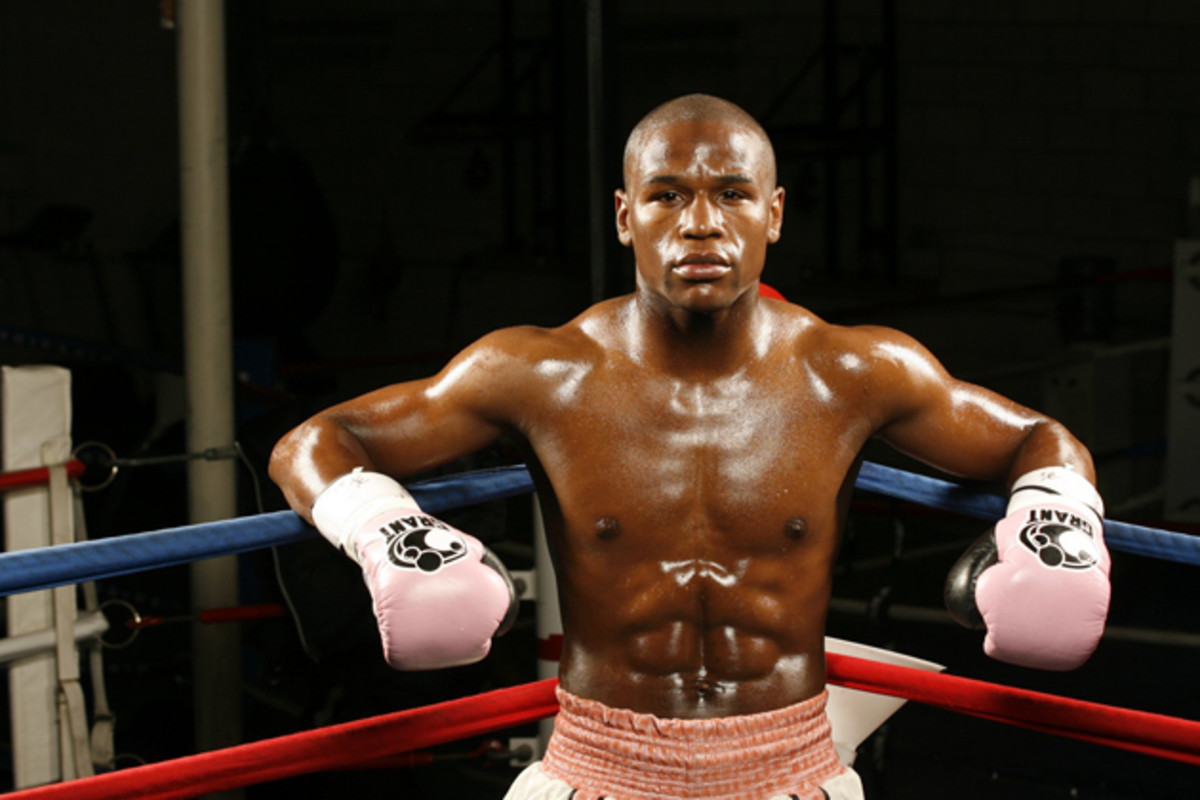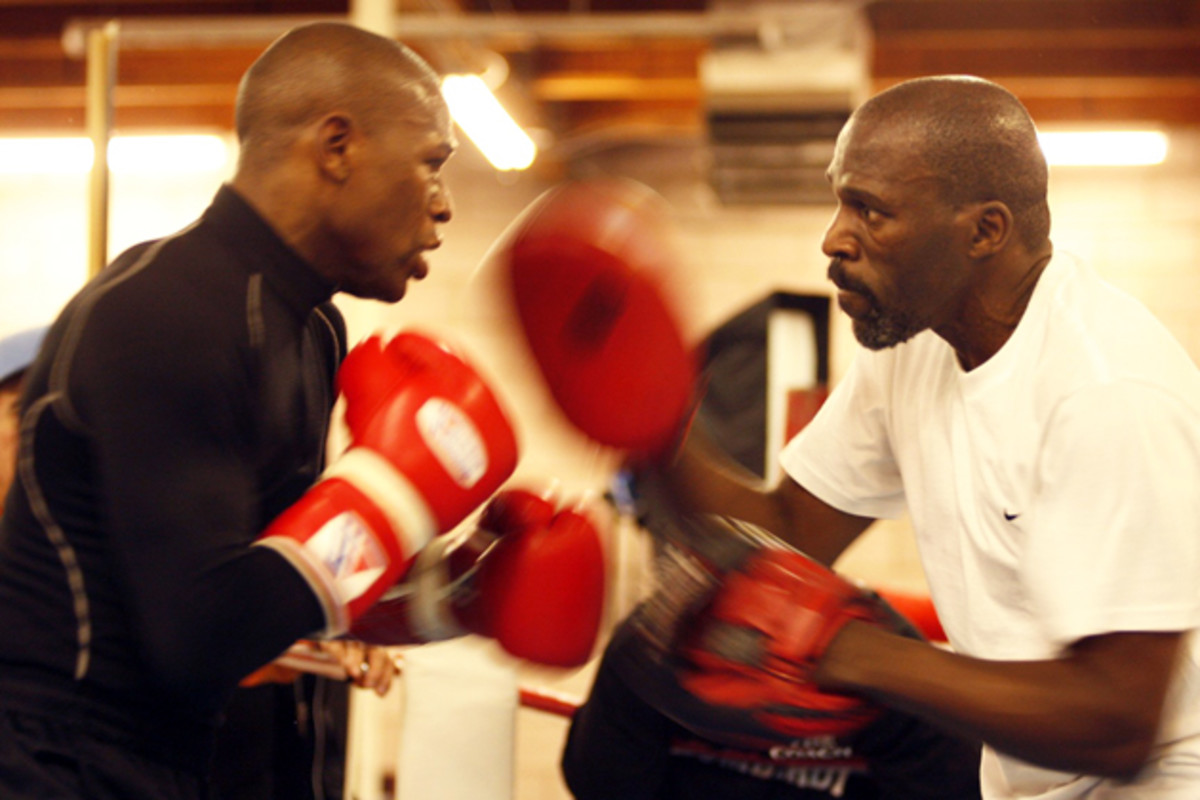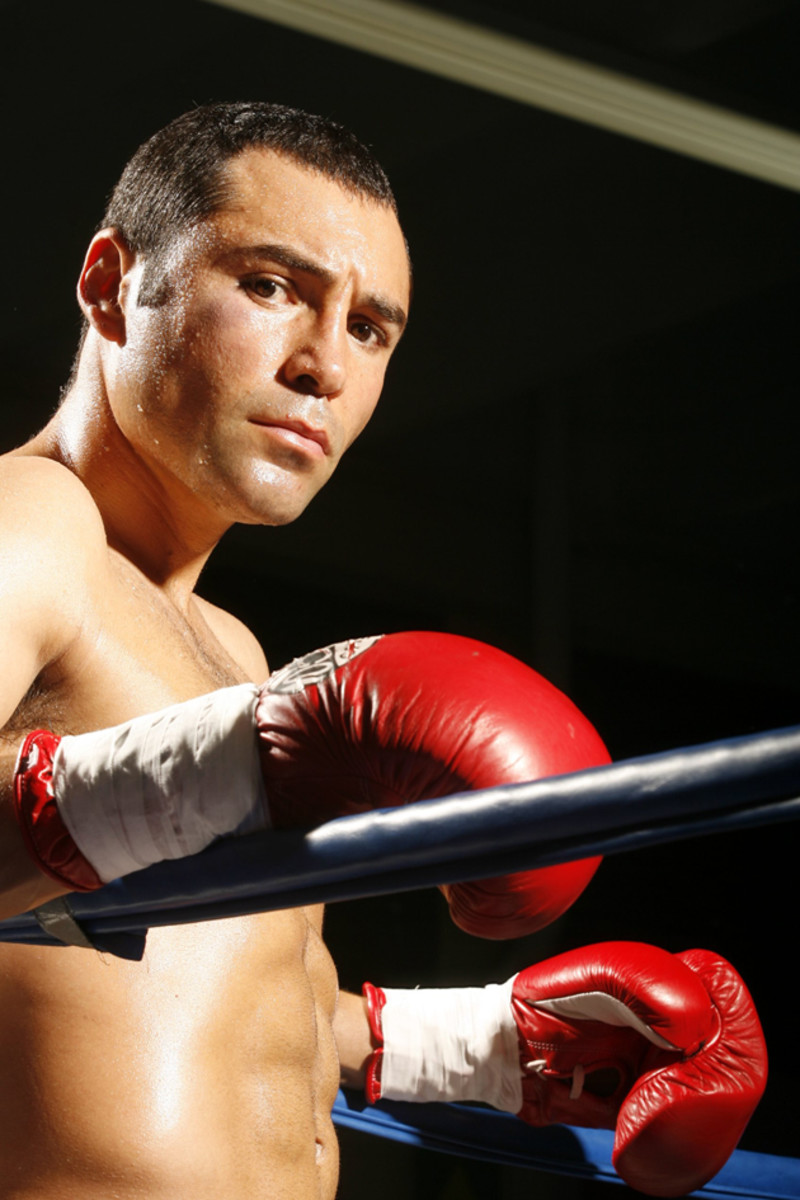SI Vault: Mayweather's record-breaking 2007 fight vs. De La Hoya

This story appears in the May 7, 2007, issue of Sports Illustrated. Subscribe to the magazine here.
As anticipation builds for Floyd Mayweather's May 2 showdown with Manny Pacquiao, we take a look back at his 2007 bout against Oscar De La Hoya, a match that pitted Mayweather against the sport's other superstar of the time and—like Floyd vs. Manny—drew wide attention from beyond boxing. Mayweather-De La Hoya set a record for pay-per-view buys (2.4 million) that still stands and generated around $136 million in revenue. Seven years later, Mayweather remains undefeated, and he and Pacquiao seem poised to eclipse those numbers.
Golden Boy vs. Pretty Boy
In a Las Vegas gym, far from the boardrooms, Floyd Mayweather Jr. chops at a heavy bag, slowly circling it, punch by punch. "I like [whomp!] having [whomp!] $10,000 [whomp!] in my [whomp!] pocket." His personal videographer, who has eight years' worth of film to edit so far, revolves with him, trying to keep out of the way of Mayweather's personal photographer, who is in similar orbit. "I like [whomp!] having a [whomp!] cook [whomp!]. I like [whomp!] having [whomp!] a driver." Two assigned punch counters (one is counting by hand—"seven, eight, nine, 2,000!"—the other clicking on a small device for backup) move with him, adding to the effect of a small but needlessly complicated planetary system. Mayweather chops away, narrating his lifestyle, as if his work here requires explanation. "I like [whomp!] having [whomp!] a big house." The entourage shuffles along in cycloid congestion, documenting and affirming, until Mayweather suddenly drops his arms, not so much because they are tired as because he has begun to repeat himself. Above all, it seems, he likes having (whomp!) $10,000 in his pocket. Everyone is pleased with the drill, clapping and whistling. The man with the clicker shows me the count: 6,261. I remember now that Mayweather had, altogether spontaneously, set out to "crack off" 1,000 straight punches, to the delight and astonishment of the crowd gathered near the ring. He has (whomp!) overshot.
• BISHOP: In the gym with Floyd: Mayweather looks serious
As he moves off, a dozen people trailing in his gravitational wake, I marvel at such wonderful desperation. You see this only at the highest levels of performance. Mayweather's drive is so deep-seated that at first it's hard to see the doubt that inspires him, and he tends to come off as heedless, irrepressible and, above all, childish. He never seems at work, but rather at play. In fact, the day's training is in jeopardy when somebody produces a giant jar of Twizzlers. The camp has taken on Mayweather's attention-deficit persona and is impossible to keep on track for very long. Everyone dives into the jar. Crazy. How much is at stake here? How many hundreds of millions? Then again, didn't Mayweather, at 3 a.m. this very day, spring upright in bed and send out a call to gather everybody at the gym? I imagine that gloomy phone tree. It was, however, by no means the first time that the gang had assembled in the Nevada moonlight. Indeed, like firefighters wired to answer alarms, they do it all the time, only these men are chronically attuned to whim.
If Mayweather is truly desperate—and nothing else explains his fanaticism—this is good news back in the boardrooms. His fight with Oscar De La Hoya on Saturday night at the MGM Grand in Vegas will probably be boxing's last gasp, surely the last bout that can produce anything like coast-to-coast appeal or, let's say, two million pay-per-view buys. Unless De La Hoya is fighting, which has been seldom of late and is about to become never, the sport exists on the fringes, particularly in the U.S. The lower weight classes are dominated by Hispanic fighters, and their fights, dramatic as they might be, are marketed almost exclusively in the West, Southwest and some big cities elsewhere. The heavyweight division, which traditionally galvanized the nation, is similarly dominated by foreign fighters, but with the added disadvantage that they're not very good.

In short, De La Hoya–Mayweather just might be boxing's last megafight, the last event of its kind, the last time a bout features two widely known athletes and is a topic of national interest. There will be boxing, and lots of it will be quite good, but there may never again be a time when boxing penetrates this country's indifference and causes a viral, all-consuming hubbub.
The reasons for boxing's decline, or at least its transition to a specialty sport, have been outlined in these pages before. The Olympics, once a springboard to stardom, no longer provide boxing any exposure in this country. It's been a long time, perhaps since De La Hoya won his gold medal in Barcelona in 1992, that kids in this country could be goaded into a gym with the promise of glory. Globalization, which ought to be good for boxing, a traditional melting pot, has instead turned it into a nightmare of competing ethnicities, with niche marketing now the norm.
On top of all this, there has been the sudden and surprising emergence of mixed martial arts. The Ultimate Fighting Championship, which has been selling out Las Vegas arenas for several years now, is lately making big bucks with its own pay-per-view shows. It skews much younger, imbuing Gen Xers with an appreciation of leg sweeps instead of left hooks. Boxing's demographic is increasingly made up of people who eat early-bird specials and wonder what e-mail is. And it will get only worse. "It's a bit like horse racing," says Marc Ratner, longtime executive director of the Nevada State Athletic Commission, which oversees boxing in the state, "and you wonder about that." (Indeed. Ratner recently switched sides and went to work for the UFC.) Saturday night's fight will not change this but will instead represent something of a last hurrah. The riches this bout will produce (the $19 million gate, the potential $100 million PPV haul) will most likely not be matched. Not on one night, anyway.
In the boardrooms there seems to be a reluctant recognition of this. While old boxing hands argue that the sport is merely in a lull—"Boxing has gone through ebbs and flows in its history," says HBO Sports president Ross Greenburg, whose network, long among the sport's biggest boosters, is essentially promoting the fight and televising it on PPV—there is nevertheless a sense of urgency. Blessed with two remarkable fighters, terrific subplots and a looming deadline of De La Hoya's expected retirement, HBO (which, like SI, is owned by Time Warner) has pulled out all the stops. And that includes foisting an hourlong PowerPoint presentation on a cadre of bewildered boxing writers.
Basically, according to the slide show, everybody's doing a lot of stuff. Here's some of it: As the promoter of record, De La Hoya's company, Golden Boy, leased a pair of Gulfstream jets to ferry the fighters on a nine-day, 11-city tour. The stopovers served to remind the cable-ready universe that the 34-year-old De La Hoya, only sporadically active (or successful) over the last several years, had regained his appetite, his nerve and his megasmile. Also that Mayweather, 30, undefeated and a champion for a decade, was not so intimidated by moving up from welterweight to challenge De La Hoya, the WBC champion, at this new weight of 154. "Golden Girl," Mayweather called him.
De La Hoya deserves better than that, of course, having ruled six divisions and run up a 38–4 record (with 30 KOs) during his 15-year career, his left hook as impressive as his smile. He still has some crunch in him and could be dangerous at this weight. Mayweather (37–0, with 24 KOs), who has an equally impressive set of choppers, is the quicker and shiftier boxer and will be the favorite in the fight for it. But even as a shoulder-rolling phantom, his power, never his strong suit, becomes suspect as he moves up in weight to meet De La Hoya.
[pagebreak]

The fighters' tour was a staple of big-time promotion in the 1970s and '80s, when Sugar Ray Leonard, Marvelous Marvin Hagler, Tommy Hearns and Roberto Durán were repeatedly squaring off. It hasn't been used as much, or as effectively, in recent years. With De La Hoya consistently taking the high road and the puckish Mayweather playing his recklessly rude foil, there could hardly have been more drama, or comedy. Mayweather seemed to be beside himself on the tour, hatching caper after caper (producing a live chicken with a gold medal around its neck, stealing De La Hoya's bag) and generally getting under his opponent's skin. When the two parties ate in the same restaurant, someone from Mayweather's table took food from a cart headed for De La Hoya. "I mean, who acts like that?" says De La Hoya, shaking his head.
But if the tour was old school, the HBO documentary (or reality show, or infomercial, depending on where you dial in your cynicism), 24/7, was something very new. Its four half-hour segments, shown after The Sopranos and Entourage on Sundays, were an all-access peek into the two fighters' camps. The shows were so profane that even promoter Bob Arum (who has been involved with both fighters) was aghast: "I mean, what the f--- was that!" But they were also funny, not a little revealing and a shrewd ramp-up to Saturday's event. Toggling between two entirely different lifestyles (De La Hoya sips cappuccino that his wife, Puerto Rican pop star Millie Corretjer, made for him at their San Juan estate; rapper 50 Cent materializes on a Segway while Mayweather gets a haircut at his Las Vegas estate), HBO easily made the case for rooting interests while also providing a benchmark for televised surrealism.
SI Vault: The Golden Son, that's what Floyd Mayweather Jr. wants to be
When you promise your fighters estimated purses of $25 million (for De La Hoya) and $10 million (for Mayweather), you need to find promotional leverage where you never looked before. So in addition to 24/7, HBO boasted of "600 million impressions," worth $25 million, in its PowerPoint show. Nobody at the press conference had any idea what that meant. Advertising, possibly? Better understood was the Tecate beer marketing in 14,000 7-Elevens, and the Rockstar energy drink promotion in 11,000 Circle K's. This kind of sponsorship for a fight is certainly unprecedented but possibly now required.
"Somewhere along the way," says Greenburg, "[boxing] lost the average fan. But I think we're earmarking this as the fight that can bring him back. In many ways this is the Super Bowl of boxing. We can get that viewer back once again, to create the beauty and drama of this sport."
The problem is, once the viewer is back, he may not stay. For all of Mayweather's pound-for-pound excellence, his willingness to play the heel and his entertainment value, this is still De La Hoya's promotion. He is boxing's biggest breadwinner since Mike Tyson and Evander Holyfield surrendered the heavyweight division; in total PPV revenue his take is $492 million from 17 events, third behind the two big men. And with this fight he will easily topple Tyson's career haul of $545 million. In terms of single-fight buys, the 1.4 million for De La Hoya's bout with Félix Trinidad in 1999 remains a nonheavyweight record. And the record of 1.99 million buys for Tyson-Holyfield II in '97 is within reach.

De La Hoya has been notoriously cagey and unreliable when it comes to setting his retirement date. He was never going to fight into his 30s, remember? It's been a year since he knocked out Ricardo Mayorga and 2 1/2 years since he lost to Bernard Hopkins in an ill-fated but lucrative step up to the 160-pound division, but he always finds a reason to come back for one more payday. However, with an estimated net worth of $150 million (prefight) and with investments in publishing, banking, fight promotion and real estate, he may be hard-pressed to find many more reasons.
Mayweather's box-office clout, without the ability to cross over into the Hispanic market, is paltry in comparison with De La Hoya's, and he has never become the attraction his talents seemed to predict. This puzzles most followers of the game, because Mayweather's impish charm trumps De La Hoya's less-authentic public persona. There's hardly anyone more fun to be around than Mayweather. But he's also capable of nastiness--blasting the very people who bankroll him. Also, there's the matter of his family.
• BISHOP: For Floyd Mayweather, fight vs. Pacquiao puts legacy at stake
If we got a nickel every time we used the word dysfunctional in a Mayweather story, we could more easily afford to buy his pay-per-view fights. But the family is unusual. Floyd Sr., who as a trainer was seen not so long ago in De La Hoya's corner, developing game plans and off-the-wall rhymes, was never truly estranged from his son, but their relationship has had its ups and downs, not limited to the time in 2000 that Junior evicted Senior from his house. The father, save for a 5 1/2-year prison stint on drug charges, was demanding when it came to the son's boxing career, requiring a perfection that not even Floyd Jr. could deliver. The son, though admitting that he still works to please the father, chafed and fired him first chance he got.
In his place he installed his father's brother, which produced even more sensational family dynamics. Roger Mayweather, like Floyd Jr., could not take the old man's blathering. They never got along, and they still snipe at each other at every opportunity. The young fighter has handled this better than you might have expected, even though his father was De la Hoya's trainer of record until January. Give Senior this, though. Rather than continue to train a man to destroy his son, he essentially fired himself by asking for an unheard-of $2 million to remain in De La Hoya's corner. De La Hoya replaced him with veteran Freddie Roach.
Floyd Mayweather a big challenge for Pacquiao trainer Freddie Roach
The family dynamic got a further tweak last September when Roger was sentenced to six months in prison for decking the grandmother of his child. Now who would train Floyd Jr.? Floyd Sr. was seen around the gym, looking to help, but his son set him straight. "I love my father," Floyd Jr. says, but Floyd Sr. is no longer his trainer. As soon as Roger got out of the can in March, it was back to business, although it can get a little tense with the two brothers eyeing each other from under those furrowed brows.
Floyd Jr. has streamlined his life; he says he hardly ever goes out in full party mode anymore, preferring to stay in his Vegas manse to watch basketball on one or more of his six plasma TVs. He bets the games but says that's his only vice. Well, he likes to shop, too, which is why he needs that $10,000 in his pocket. "You never know when you might need a Brioni shirt," he says. And just as he's likely to roust his crew for a midnight run, he might as easily give them a call to meet him at Niketown or Ruth's Chris. His burn rate is a function of boredom.
Mostly, he likes to be in the gym. Here he is, on what's supposed to be a day off, hitting the mitts with Roger. Maybe the peculiar exhilaration of boxing will no longer appeal to a mass audience. Maybe the sport really will be driven into corners only connoisseurs can find. But its pleasures will be no less intense for all that. Anyway, here's Mayweather at his trade, in a spectacle of syncopation, firing off combinations according to a secret plan, his uncle catching them with his mitts (and the videographer and photographer circling cautiously). There are three-punch combinations, five-, 10-, 20-punch flurries of pinpoint delivery. Floyd steadily increases the pace until the staccato pop-pop-pop of his gloves begins to sound like machinery.
And then I notice that Floyd and Roger are not looking at each other but are staring off into space, as if enjoying a private reverie, or maybe it's a shared disdain for the sport's simplicity. Who can tell with these characters? And then (this is almost impossible to believe) I see that Roger's two-year-old son, Lakai, has crawled into the ring and attached himself to his father's leg. There is no break in the action, which increases, if anything, Roger continuing to catch blows--here, there, everywhere--while lugging his son around on his leg. Nobody's looking at anybody, and the punches are flying, just flying. Finally someone shouts "Time!" and the drill is ended. Everybody claps and whistles.
